Pragmatic Language Impairment: A Scientometric Review
Abstract
:1. Introduction
1.1. The Rise of Pragmatic Language Impairment
1.2. The Scope of Pragmatic Language Impairment
1.3. Pragmatic Language Impairment and Autism Spectrum Disorder
1.4. Diagnostic Instruments for Pragmatic Language Impairment
1.5. Scientific Contributions for Pragmatic Language Impairment
1.6. Purpose of the Present Study
- Bibliometric Question: How have production size, geographical contribution, source, and citation trends in the field of Pragmatic Language Impairment evolved over time, and which authors, universities, and publishers have emerged as the most influential contributors to this domain’s knowledge base?
- Scientometric Question: In the context of PLI research, how have betweenness centrality, burst detection, co-citation, silhouette, sigma, and clusters evolved, and what does this reveal about the consistency, strength, and relatedness of the nodes within this field? Additionally, how does the co-occurrence of author keywords and citation patterns inform us about the development and primary focus areas of this research domain?
2. Methods
2.1. Research Methods
2.2. Measures
2.3. Data-Collection and Sample
2.4. Data Analysis
3. Results
3.1. Result Overview
3.2. Bibliometric Indicators for the Study of Pragmatic Language Impairment
3.2.1. Overview of PLI Studies from Scopus, Web of Science, and Lens
3.2.2. Production of Pragmatic Language Impairment Research by Country and University
3.2.3. Production of Pragmatic Language Impairment Research by Journal and Publisher
3.2.4. Production of Pragmatic Language Impairment by Research Area, Keywords, and Co-Occurrence
3.2.5. Production of Pragmatic Language Impairment by Authors
3.3. Scientometric Indicators for the Study of Pragmatic Language Impairment
Overview of PLI Studies from Scopus, Web of Science, and Lens
3.4. Impact of Research on Pragmatic Language Impairment by Clusters, Citation Counts, Citation Bursts, Centrality, and Sigma
3.4.1. Clusters
3.4.2. Citation Counts
3.4.3. Bursts
3.4.4. Centrality
3.4.5. Sigma
4. Discussion
5. Conclusions
Author Contributions
Funding
Institutional Review Board Statement
Informed Consent Statement
Data Availability Statement
Acknowledgments
Conflicts of Interest
References
- Qasem, F.; Alduais, A.; Alfadda, H.; Alfadda, N.; AlAmri, L. A Study on the Relationship between Pragmatic Language Development and Socioeconomic Status in Arab Preschoolers with and without Pragmatic Language Impairment. Sustainability 2022, 14, 6369. [Google Scholar] [CrossRef]
- Alduais, A.; Qasem, F.; Alfadda, H.; Alfadda, N.; AlAmri, L. Arabic Validation of the Pragmatic Language Skills Inventory to Assess Pragmatic Language Development in Preschoolers with and without Pragmatic Language Impairment. Children 2022, 9, 809. [Google Scholar] [CrossRef]
- Alduais, A.; Majorano, M.; Andrés-Roqueta, C.; Hamaguchi, P.; Persici, V.; Qasem, F. Conceptualizing, Defining, and assessing Pragmatic Language impairment of preschoolers: A scoping Review (Title Registration). OSF 2021. [Google Scholar] [CrossRef]
- Alduais, A.M.S. Identifying Typical and Atypical Manifestations of Pragmatic Language Impairment in Arabic: A Multi-Method Study of Individuals with Developmental Dysphasia. Ph.D. Thesis, King Saud University (Saudi Arabia), Ann Arbor, MI, USA, 2013. [Google Scholar]
- Alduais, A. Pragmatic Language Impairment & Developmental Dysphasia; LAP Lambert Academic Publishing: Saarbrücken, Germany, 2013; ISBN 9781787284395. [Google Scholar]
- American Psychiatric Association. American Psychiatric Association Diagnostic and Statistical Manual of Mental Disorders, 5th ed.; American Psychiatric Association: Washington, DC, USA, 2013. [Google Scholar]
- Rapin, I.; Allen, D.A. Developmental Language Disorders: Nosologic Considerations. In Neuropsychology of Language, Reading and Spelling; Elsevier: Amsterdam, The Netherlands, 1983; pp. 155–184. [Google Scholar]
- Bishop, D.V.M.; Rosenbloom, L. Classification of Childhood Language Disorders. In Language Development and Disorders (Clinics in Developmental Medicine, Nos. 101-2); Yule, W., Ruttter, M., Eds.; Mac Keith: London, UK, 1987; pp. 16–41. [Google Scholar]
- Bishop, D.V.M. Development of the Children’s Communication Checklist (CCC): A Method for Assessing Qualitative Aspects of Communicative Impairment in Children. J. Child Psychol. Psychiatry 1998, 39, 879–891. [Google Scholar] [CrossRef]
- Bishop, D. Pragmatic Language Impairment: A Correlate of SLI, a Distinct Subgroup, or Part of the Autistic Continuum. In Speech and Language Impairments in Children; Psychology Press: London, UK, 2000; pp. 99–113. [Google Scholar]
- Ryder, N.; Leinonen, E.; Schulz, J. Cognitive Approach to Assessing Pragmatic Language Comprehension in Children with Specific Language Impairment. Int. J. Lang. Commun. Disord. 2008, 43, 427–447. [Google Scholar] [CrossRef]
- Shields, J.; Varley, R.; Broks, P.; Simpson, A. Social Cognition in Developmental Language Disorders and High-Level Autism. Dev. Med. Child Neurol. 1996, 38, 487–495. [Google Scholar] [CrossRef]
- Norbury, C.F.; Bishop, D.V.M. Inferential Processing and Story Recall in Children with Communication Problems: A Comparison of Specific Language Impairment, Pragmatic Language Impairment and High-Functioning Autism. Int. J. Lang. Commun. Disord. 2002, 37, 227–251. [Google Scholar] [CrossRef]
- Bishop, D.V.M.; Norbury, C.F. Exploring the Borderlands of Autistic Disorder and Specific Language Impairment: A Study Using Standardised Diagnostic Instruments. J. Child Psychol. Psychiatry Allied Discip. 2002, 43, 917–929. [Google Scholar] [CrossRef]
- Spekman, N.J.; Roth, F.P. Intervention Strategies for Learning Disabled Children with Oral Communication Disorders. Learn. Disabil. Q. 1984, 7, 7–18. [Google Scholar] [CrossRef]
- Ketelaars, M.P.; Embrechts, M.T.J.A. Pragmatic Language Impairment. In Perspectives in Pragmatics, Philosophy & Psychology; Cummings, L., Ed.; Springer International Publishing: Cham, Switzerland, 2017; Volume 11, pp. 29–57. ISBN 978-3-319-47487-8. [Google Scholar]
- Rapin, I.; Allen, D.A. Developmental Dysphasia and Autism in Preschool Children: Characteristics and Subtypes; Indiana University: Bloomington, IN, USA, 1987. [Google Scholar]
- Leinonen, E.; Letts, C. Why Pragmatic Impairment? A Case Study in the Comprehension of Inferential Meaning. Eur. J. Disord. Commun. 1997, 32, 35–51. [Google Scholar] [CrossRef]
- Rapin, I.; Allen, D.A. The Semantic-Pragmatic Deficit Disorder: Classification Issues. Int. J. Lang. Commun. Disord. 1998, 33, 82–87. [Google Scholar] [PubMed]
- Bishop, D.V.M. Autism, Asperger’s Syndrome and Semantic-Pragmatic Disorder: Where Are the Boundaries? Br. J. Disord. Commun. 1989, 24, 107–121. [Google Scholar] [CrossRef] [PubMed]
- Botting, N. Narrative as a Tool for the Assessment of Linguistic and Pragmatic Impairments. Child Lang. Teach. Ther. 2002, 18, 1–21. [Google Scholar] [CrossRef]
- Norbury, C.F.; Bishop, D.V.M. Narrative Skills of Children with Communication Impairments. Int. J. Lang. Commun. Disord. 2003, 38, 287–313. [Google Scholar] [CrossRef] [PubMed]
- American Psychiatric Association. Continuing Medical Education Syllabus and Scientific Proceedings in Summary Form: Annual Meeting of the American Psychiatric Association 1994; American Psychiatric Association: Washington, DC, USA, 1994. [Google Scholar]
- Botting, N.; Conti-Ramsden, G. Pragmatic Language Impairment without Autism. Autism 1999, 3, 371–396. [Google Scholar] [CrossRef]
- Norbury, C.F. Practitioner Review: Social (Pragmatic) Communication Disorder Conceptualization, Evidence and Clinical Implications. J. Child Psychol. Psychiatry 2014, 55, 204–216. [Google Scholar] [CrossRef]
- Reisinger, L.M.; Cornish, K.M.; Fombonne, É. Diagnostic Differentiation of Autism Spectrum Disorders and Pragmatic Language Impairment. J. Autism Dev. Disord. 2011, 41, 1694–1704. [Google Scholar] [CrossRef]
- Gibson, J.; Adams, C.; Lockton, E.; Green, J. Social Communication Disorder Outside Autism? A Diagnostic Classification Approach to Delineating Pragmatic Language Impairment, High Functioning Autism and Specific Language Impairment. J. Child Psychol. Psychiatry 2013, 54, 1186–1197. [Google Scholar] [CrossRef]
- Wetherby, A.M.; Prizant, B.M. Communication and Symbolic Behavior Scales: Developmental Profile; Brookes Publishing: Baltimore, MD, USA, 2002. [Google Scholar]
- Simmons, E.S. Yale in Vivo Pragmatic Protocol. In Encyclopedia of Autism Spectrum Disorders; Springer: New York, NY, USA, 2017; pp. 1–2. [Google Scholar]
- Phelps-Terasaki, D.; Phelps-Gunn, T. TOPL-2: Test of Pragmatic Language, 2nd ed.; Proed: Austin, TX, USA, 2007. [Google Scholar]
- Mundy, P.; Delgado, C.; Block, J.; Venezia, M.; Hogan, A.; Seibert, J. Early Social Communication Scales (ESCS); MIND Institute, University of California at Davis: Davis, CA, USA, 2003. [Google Scholar]
- Journal of Pragmatics. Available online: https://www.journals.elsevier.com/journal-of-pragmatics (accessed on 23 March 2022).
- Language and Speech Language and Speech. Available online: https://journals.sagepub.com/home/las (accessed on 22 March 2022).
- International Pragmatics Association International Pragmatics Association (IPrA). Available online: https://pragmatics.international/ (accessed on 16 March 2022).
- Adams, C. Practitioner Review: The Assessment of Language Pragmatics. J. Child Psychol. Psychiatry Allied Discip. 2002, 43, 973–987. [Google Scholar] [CrossRef]
- Martin, I.; McDonald, S. Weak Coherence, No Theory of Mind, or Executive Dysfunction? Solving the Puzzle of Pragmatic Language Disorders. Brain Lang. 2003, 85, 451–466. [Google Scholar] [CrossRef]
- Geurts, H.M.; Hartman, C.; Verte, S.; Oosterlaan, J.; Roeyers, H.; Sergeant, J.A. Pragmatics Fragmented: The Factor Structure of the Dutch Children’s Communication Checklist (CCC). Int. J. Lang. Commun. Disord. 2009, 44, 549–574. [Google Scholar] [CrossRef] [PubMed]
- Weed, E. What’s Left to Learn about Right Hemisphere Damage and Pragmatic Impairment? Aphasiology 2011, 25, 872–889. [Google Scholar] [CrossRef]
- Amoretti, M.C.; Lalumera, E.; Serpico, D. The DSM-5 Introduction of the Social (Pragmatic) Communication Disorder as a New Mental Disorder: A Philosophical Review. Hist. Philos. Life Sci. 2021, 43, 108. [Google Scholar] [CrossRef] [PubMed]
- Swineford, L.B.; Thurm, A.; Baird, G.; Wetherby, A.M.; Swedo, S. Social (Pragmatic) Communication Disorder: A Research Review of This New DSM-5 Diagnostic Category. J. Neurodev. Disord. 2014, 6, 41. [Google Scholar] [CrossRef]
- Baird, G.; Norbury, C.F. Social (Pragmatic) Communication Disorders and Autism Spectrum Disorder. Arch. Dis. Child. 2016, 101, 745–751. [Google Scholar] [CrossRef] [PubMed]
- Cummings, L. Theory of Mind in Utterance Interpretation: The Case from Clinical Pragmatics. Front. Psychol. 2015, 6, 1286. [Google Scholar] [CrossRef]
- Topal, Z.; Samurcu, N.D.; Taskiran, S.; Tufan, A.E.; Semerci, B. Social Communication Disorder: A Narrative Review on Current Insights. Neuropsychiatr. Dis. Treat. 2018, 14, 2039–2046. [Google Scholar] [CrossRef]
- Glänzel, W.; Schoepflin, U. Little Scientometrics, Big Scientometrics… and Beyond? Scientometrics 1994, 30, 375–384. [Google Scholar] [CrossRef]
- Chellappandi, P.; Vijayakumar, C.S. Bibliometrics, Scientometrics, Webometrics/Cybermetrics, Informetrics and Altmetrics—An Emerging Field in Library and Information Science Research. Int. J. Educ. 2018, 7, 5–8. [Google Scholar] [CrossRef]
- Egghe, L. Little Science, Big Science… and Beyond. Scientometrics 1994, 30, 389–392. [Google Scholar] [CrossRef]
- Parkinson, M. The Evaluation of Research by Scientometric Indicators. Libr. Manag. 2011, 32, 226–229. [Google Scholar] [CrossRef]
- Huang, Y.; Glänzel, W.; Zhang, L. Tracing the Development of Mapping Knowledge Domains. Scientometrics 2021, 126, 6201–6224. [Google Scholar] [CrossRef]
- Sooryamoorthy, R. Scientometrics for the Humanities and Social Sciences; Routledge: New York, NY, USA, 2020; ISBN 9780367626860. [Google Scholar]
- Birkle, C.; Pendlebury, D.A.; Schnell, J.; Adams, J. Web of Science as a Data Source for Research on Scientific and Scholarly Activity. Quant. Sci. Stud. 2020, 1, 363–376. [Google Scholar] [CrossRef]
- Burnham, J.F. Scopus Database: A Review. Biomed. Digit. Libr. 2006, 3, 1. [Google Scholar] [CrossRef]
- Pranckutė, R. Web of Science (WoS) and Scopus: The Titans of Bibliographic Information in Today’s Academic World. Publications 2021, 9, 12. [Google Scholar] [CrossRef]
- Penfold, R. Using the Lens Database for Staff Publications. J. Med. Libr. Assoc. 2020, 108, 520–522. [Google Scholar] [CrossRef]
- Chen, C. The CiteSpace Manual: Version 1.01; College of Computing and Informatics, 2014; pp. 1–84. Available online: https://citespace.podia.com/download (accessed on 1 March 2023).
- Van Eck, N.J.; Waltman, L. VOSviewer Manual: Manual for VOSviewer Version 1.6.18; Univeristeit Leiden: Leiden, The Netherlands, 2022. [Google Scholar]
- Freeman, L.C. Centrality in Social Networks. Soc. Netw. 1979, 1, 215–239. [Google Scholar] [CrossRef]
- Kleinberg, J. Bursty and Hierarchical Structure in Streams. In Proceedings of the Eighth ACM SIGKDD International Conference on Knowledge Discovery and Data Mining—KDD’02, Edmonton, AB, Canada, 23–26 July 2002; ACM Press: New York, NY, USA, 2002; p. 91. [Google Scholar]
- Chen, C. CiteSpace: A Practical Guide for Mapping Scientific Literature; Nova Science Publishers: New York, NY, USA, 2016; ISBN 9781536102956. [Google Scholar]
- Cummings, L. Pragmatic Impairment and COVID-19. Intercult. Pragmat. 2022, 19, 271–297. [Google Scholar] [CrossRef]
- Bambini, V.; Arcara, G.; Martinelli, I.; Bernini, S.; Alvisi, E.; Moro, A.; Cappa, S.F.; Ceroni, M. Communication and Pragmatic Breakdowns in Amyotrophic Lateral Sclerosis Patients. BRAIN Lang. 2016, 153, 1–12. [Google Scholar] [CrossRef]
- Adams, C.; Gaile, J. Evaluation of a Parent Preference-Based Outcome Measure after Intensive Communication Intervention for Children with Social (Pragmatic) Communication Disorder and High-Functioning Autism Spectrum Disorder. Res. Dev. Disabil. 2020, 105, 103752. [Google Scholar] [CrossRef]
- Happé, F.; Brownell, H.; Winner, E. Acquired ‘theory of Mind’ Impairments Following Stroke. Cognition 1999, 70, 211–240. [Google Scholar] [CrossRef] [PubMed]
- Southgate, V.; Senju, A.; Csibra, G. Action Anticipation through Attribution of False Belief by 2-Year-Olds. Psychol. Sci. 2007, 18, 587–592. [Google Scholar] [CrossRef]
- Frischen, A.; Bayliss, A.P.; Tipper, S.P. Gaze Cueing of Attention: Visual Attention, Social Cognition, and Individual Differences. Psychol. Bull. 2007, 133, 694–724. [Google Scholar] [CrossRef]
- Thomson, H.; Petticrew, M.; Morrison, D. Health Effects of Housing Improvement: Systematic Review of Intervention Studies. BMJ 2001, 323, 187–190. [Google Scholar] [CrossRef] [PubMed]
- Wang, A.T.; Lee, S.S.; Sigman, M.; Dapretto, M. Neural Basis of Irony Comprehension in Children with Autism: The Role of Prosody and Context. Brain 2006, 129, 932–943. [Google Scholar] [CrossRef]
- Bishop, D.V.M.; Snowling, M.J.; Thompson, P.A.; Greenhalgh, T. Phase 2 of CATALISE: A Multinational and Multidisciplinary Delphi Consensus Study of Problems with Language Development: Terminology. J. Child Psychol. Psychiatry 2017, 58, 1068–1080. [Google Scholar] [CrossRef] [PubMed]
- Van de Cruys, S.; Evers, K.; Van der Hallen, R.; Van Eylen, L.; Boets, B.; De-Wit, L.; Wagemans, J. Precise Minds in Uncertain Worlds: Predictive Coding in Autism. Psychol. Rev. 2014, 121, 649–675. [Google Scholar] [CrossRef]
- Landa, R.; Piven, J.; Wzorek, M.M.; Gayle, J.O.; Chase, G.A.; Folstein, S.E. Social Language Use in Parents of Autistic Individuals. Psychol. Med. 1992, 22, 245–254. [Google Scholar] [CrossRef]
- Crespi, B.; Badcock, C. Psychosis and Autism as Diametrical Disorders of the Social Brain. Behav. Brain Sci. 2008, 31, 241–261. [Google Scholar] [CrossRef]
- McPartland, J.C.; Reichow, B.; Volkmar, F.R. Sensitivity and Specificity of Proposed DSM-5 Diagnostic Criteria for Autism Spectrum Disorder. J. Am. Acad. Child Adolesc. Psychiatry 2012, 51, 368–383. [Google Scholar] [CrossRef]
- Baron-Cohen, S. Social and Pragmatic Deficits in Autism: Cognitive or Affective? J. Autism Dev. Disord. 1988, 18, 379–402. [Google Scholar] [CrossRef] [PubMed]
- Conti-Ramsden, G.; Botting, N. Social Difficulties and Victimization in Children with SLI at 11 Years of Age. J. Speech Lang. Hear. Res. 2004, 47, 145–161. [Google Scholar] [CrossRef] [PubMed]
- Conti-Ramsden, G.; Crutchley, A.; Botting, N. The Extent to Which Psychometric Tests Differentiate Subgroups of Children With SLI. J. Speech Lang. Hear. Res. 1997, 40, 765–777. [Google Scholar] [CrossRef] [PubMed]
- Senju, A.; Johnson, M.H. The Eye Contact Effect: Mechanisms and Development. Trends Cogn. Sci. 2009, 13, 127–134. [Google Scholar] [CrossRef]
- Filipek, P.A.; Accardo, P.J.; Baranek, G.T.; Cook, E.H.; Dawson, G.; Gordon, B.; Gravel, J.S.; Johnson, C.P.; Kallen, R.J.; Levy, S.E.; et al. The Screening and Diagnosis of Autistic Spectrum Disorders. J. Autism Dev. Disord. 1999, 29, 439–484. [Google Scholar] [CrossRef]
- Norbury, C.F.; Nash, M.; Baird, G.; Bishop, D.V.M. Using a Parental Checklist to Identify Diagnostic Groups in Children with Communication Impairment: A Validation of the Children’s Communication Checklist—2. Int. J. Lang. Commun. Disord. 2004, 39, 345–364. [Google Scholar] [CrossRef]
- Perkins, M. Pragmatic Impairment; Cambridge University Press: Cambridge, UK, 2007; ISBN 9780521790703. [Google Scholar]
- Bishop, D.V.M.; Adams, C. Conversational Characteristics of Children with Semantic-pragmatic Disorder. II: What Features Lead to a Judgement of Inappropriacy? Int. J. Lang. Commun. Disord. 1989, 24, 241–263. [Google Scholar] [CrossRef]
- Lord, C.; Schopler, E. Neurobiological Implications of Sex Differences in Autism. In Neurobiological Issues in Autism; Springer: Boston, MA, USA, 1987; pp. 191–211. [Google Scholar]
- Bishop, D.V.M.; Adams, C. What do referential communication tasks measure—A study of children with specific language impairment. Appl. Psycholinguist. 1991, 12, 199–215. [Google Scholar] [CrossRef]
- Joseph, R.M.; Tager-Flusberg, H.; Lord, C. Cognitive Profiles and Social-Communicative Functioning in Children with Autism Spectrum Disorder. J. Child Psychol. Psychiatry 2002, 43, 807–821. [Google Scholar] [CrossRef]
- Norbury, C.F. The Relationship between Theory of Mind and Metaphor: Evidence from Children with Language Impairment and Autistic Spectrum Disorder. Br. J. Dev. Psychol. 2005, 23, 383–399. [Google Scholar] [CrossRef]
- Rutter, M.; Rutter, M. Developing Minds Challenge And Continuity Across the Lifespan; Basic Books: New York, NY, USA, 1993. [Google Scholar]
- Wechsler, D. Wechsler Intelligence Scale for Children, 3rd ed.; Basic Books: New York, NY, USA, 1992. [Google Scholar]
- Tager-Flusberg, H.; Joseph, R.M. Identifying Neurocognitive Phenotypes in Autism. Philos. Trans. R Soc. London Ser. B Biol. Sci. 2003, 358, 303–314. [Google Scholar] [CrossRef]
- Conti-Ramsden, G.; Botting, N.; Faragher, B. Psycholinguistic Markers for Specific Language Impairment (SLI). J. Child Psychol. Psychiatry 2001, 42, 741–748. [Google Scholar] [CrossRef]
- Folstein, S.; Rutter, M. Genetic Influences and Infantile Autism. Nature 1977, 265, 726–728. [Google Scholar] [CrossRef] [PubMed]
- Cummings, L. (Ed.) The Routledge Pragmatics Encyclopedia; Routledge: New York, NY, USA, 2010; ISBN 9781135214579. [Google Scholar]
- Swineford, L. Screening for ASD in Toddlers: An Update on Recommendations and Practices. Perspect. ASHA Spec. Interes. Groups 2017, 2, 5–10. [Google Scholar] [CrossRef]
- McTear, M.F. Pragmatic disorders—A case-study of conversational disability. Br. J. Disord. Commun. 1985, 20, 129–142. [Google Scholar] [CrossRef]
- Greaves-Lord, K.; Eussen, M.L.J.M.; Verhulst, F.C.; Minderaa, R.B.; Mandy, W.; Hudziak, J.J.; Steenhuis, M.P.; de Nijs, P.F.; Hartman, C.A. Empirically Based Phenotypic Profiles of Children with Pervasive Developmental Disorders: Interpretation in the Light of the DSM-5. J. Autism Dev. Disord. 2013, 43, 1784–1797. [Google Scholar] [CrossRef] [PubMed]
- Dunn, J.; Brown, J. Affect Expression in the Family, Children’s Understanding of Emotions, and Their Interactions with Others. Merrill. Palmer. Q. 1994, 40, 120–137. [Google Scholar]
- Douglas, J.M. Relation of Executive Functioning to Pragmatic Outcome Following Severe Traumatic Brain Injury. J. Speech Lang. Hear. Res. 2010, 53, 365–382. [Google Scholar] [CrossRef]
- Cummings, L. Reported Speech: A Clinical Pragmatic Perspective. In Perspectives in Pragmatics, Philosophy and Psychology; Springer: New York, NY, USA, 2016; Volume 5. [Google Scholar]
- Conti-Ramsden, G.; Hutcheson, G.D.; Grove, J. Contingency and Breakdown: Children with SLI and Their Conversations with Mothers and Fathers. J. Speech Hear. Res. 1995, 38, 1290–1302. [Google Scholar] [CrossRef]
- Vohr, B.R.; Wright, L.L.; Poole, W.K.; McDonald, S.A. Neurodevelopmental Outcomes of Extremely Low Birth Weight Infants <32 Weeks’ Gestation between 1993 and 1998. Pediatrics 2005, 116, 635–643. [Google Scholar] [CrossRef]
- Bosco, F.M.; Angeleri, R.; Colle, L.; Sacco, K.; Bara, B.G. Communicative Abilities in Children: An Assessment through Different Phenomena and Expressive Means. J. Child Lang. 2013, 40, 741–778. [Google Scholar] [CrossRef] [PubMed]
- Semel, E.; Wiig, E.H.; Secord, W. Clinical Evaluation of Language Fundamentals, 5th ed.; CELF-5 UK; Pearson Education Ltd.: London, UK, 2017. [Google Scholar]
- Martin, I.; McDonald, S. Evaluating the Causes of Impaired Irony Comprehension Following Traumatic Brain Injury. Aphasiology 2005, 19, 712–730. [Google Scholar] [CrossRef]
- McDonald, S.; Flanagan, S.; Rollins, J.; Kinch, J. A New Clinical Tool for Assessing Social Perception after Traumatic Brain Injury. J. Head Trauma Rehabil. 2003, 18, 219–238. [Google Scholar] [CrossRef] [PubMed]
- Baron-Cohen, S. The Theory of Mind Deficit in Autism: How Specific Is It? Br. J. Dev. Psychol. 1991, 9, 301–314. [Google Scholar] [CrossRef]
- Bishop, D.V.M.; Adams, C. Comprehension problems in children with specific language impairment—Literal and inferential meaning. J. Speech Hear. Res. 1992, 35, 119–129. [Google Scholar] [CrossRef]
- Conti-Ramsden, G.; Gunn, M. The Development of Conversational Disability: A Case Study. Int. J. Lang. Commun. Disord. 1986, 21, 339–351. [Google Scholar] [CrossRef]
- Brinton, B.; Fujiki, M. Conversational Intervention with Children with Specific Language Impairment. In Language Intervention: Preschool through the Elementary Years; Brookes Publishing: Baltimore, MD, USA, 1995. [Google Scholar]
- Broomfield, J.; Dodd, B. Children with Speech and Language Disability: Caseload Characteristics. Int. J. Lang. Commun. Disord. 2004, 39, 303–324. [Google Scholar] [CrossRef]
- Georgiou, N.; Spanoudis, G. Developmental Language Disorder and Autism: Commonalities and Differences on Language. Brain Sci. 2021, 11, 589. [Google Scholar] [CrossRef]
- Wittke, K.; Mastergeorge, A.M.; Ozonoff, S.; Rogers, S.J.; Naigles, L.R. Grammatical Language Impairment in Autism Spectrum Disorder: Exploring Language Phenotypes beyond Standardized Testing. Front. Psychol. 2017, 8, 532. [Google Scholar] [CrossRef]
- Padilla, K.L.; Akers, J.S. Content Validity Evidence for the Verbal Behavior Milestones Assessment and Placement Program. J. Autism Dev. Disord. 2021, 51, 4054–4066. [Google Scholar] [CrossRef]
- Whitehouse, A.J.O.; Watt, H.J.; Line, E.A.; Bishop, D.V.M. Adult Psychosocial Outcomes of Children with Specific Language Impairment, Pragmatic Language Impairment and Autism. Int. J. Lang. Commun. Disord. 2009, 44, 511–528. [Google Scholar] [CrossRef] [PubMed]
- Craig, F.; Margari, F.; Legrottaglie, A.R.; Palumbi, R.; de Giambattista, C.; Margari, L. A Review of Executive Function Deficits in Autism Spectrum Disorder and Attention-Deficit/Hyperactivity Disorder. Neuropsychiatr. Dis. Treat. 2016, 12, 1191–1202. [Google Scholar] [PubMed]
- Reilly, S.; Tomblin, B.; Law, J.; McKean, C.; Mensah, F.K.; Morgan, A.; Goldfeld, S.; Nicholson, J.M.; Wake, M. Specific Language Impairment: A Convenient Label for Whom? Int. J. Lang. Commun. Disord. 2014, 49, 416–451. [Google Scholar] [CrossRef]
- Ebert, S. Theory of Mind, Language, and Reading: Developmental Relations from Early Childhood to Early Adolescence. J. Exp. Child Psychol. 2019, 191, 104739. [Google Scholar] [CrossRef]
- Agrela, N.; Santos, M.E.; Guerreiro, S. Communication after Traumatic Brain Injury: The Effectiveness of a Pragmatics Rehabilitation Programme. J. Interact. Res. Commun. Disord. 2018, 9, 172–190. [Google Scholar] [CrossRef]
- Letts, C.; Leinonen, E. Comprehension of Inferential Meaning in Language-Impaired and Language Normal Children. Int. J. Lang. Commun. Disord. 2001, 36, 307–328. [Google Scholar] [CrossRef]
- Wilson, A.C.; Bishop, D.V.M. Stage 2 Registered Report: Investigating a Preference for Certainty in Conversation among Autistic Adults. PeerJ 2022, 10, e13110. [Google Scholar] [CrossRef]
- Adams, C.; Lockton, E.; Collins, A. Metapragmatic Explicitation and Social Attribution in Social Communication Disorder and Developmental Language Disorder: A Comparative Study. J. Speech Lang. Hear. Res. 2018, 61, 604–618. [Google Scholar] [CrossRef]
- Baron-Cohen, S. Do People with Autism Understand What Causes Emotion? Child Dev. 1991, 62, 385–395. [Google Scholar] [CrossRef]
- van Eck, N.J.; Waltman, L. Visualizing Bibliometric Networks. In Measuring Scholarly Impact; Springer International Publishing: Cham, Switzerland, 2014; pp. 285–320. ISBN 9783319103761. [Google Scholar]
- van Eck, N.J.; Waltman, L.; Dekker, R.; van den Berg, J. A Comparison of Two Techniques for Bibliometric Mapping: Multidimensional Scaling and VOS. J. Am. Soc. Inf. Sci. Technol. 2010, 61, 2405–2416. [Google Scholar] [CrossRef]
- Moral-Muñoz, J.A.; Herrera-Viedma, E.; Santisteban-Espejo, A.; Cobo, M.J. Software Tools for Conducting Bibliometric Analysis in Science: An up-to-Date Review. Prof. Inf. 2020, 29, e290103. [Google Scholar] [CrossRef]
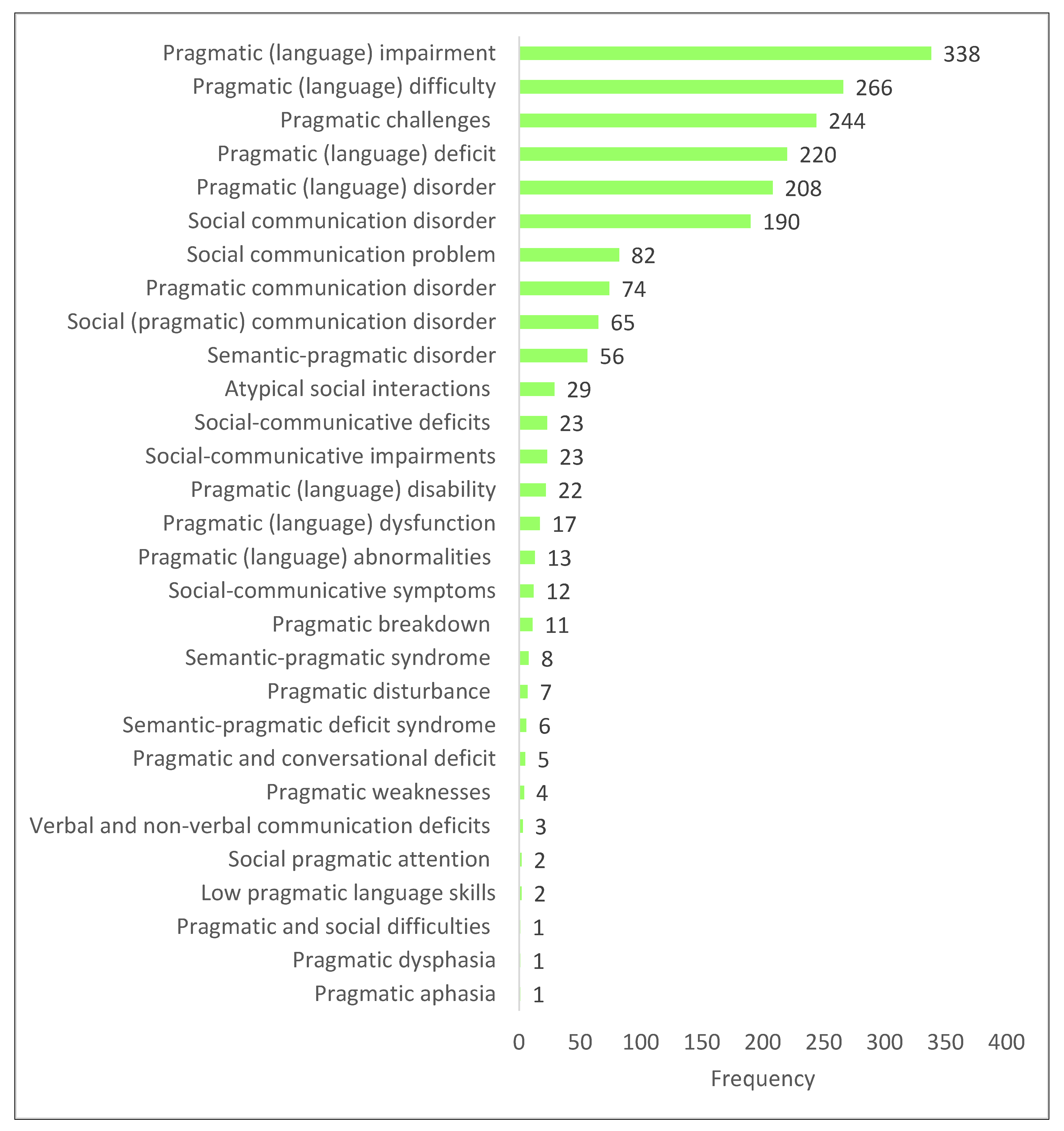
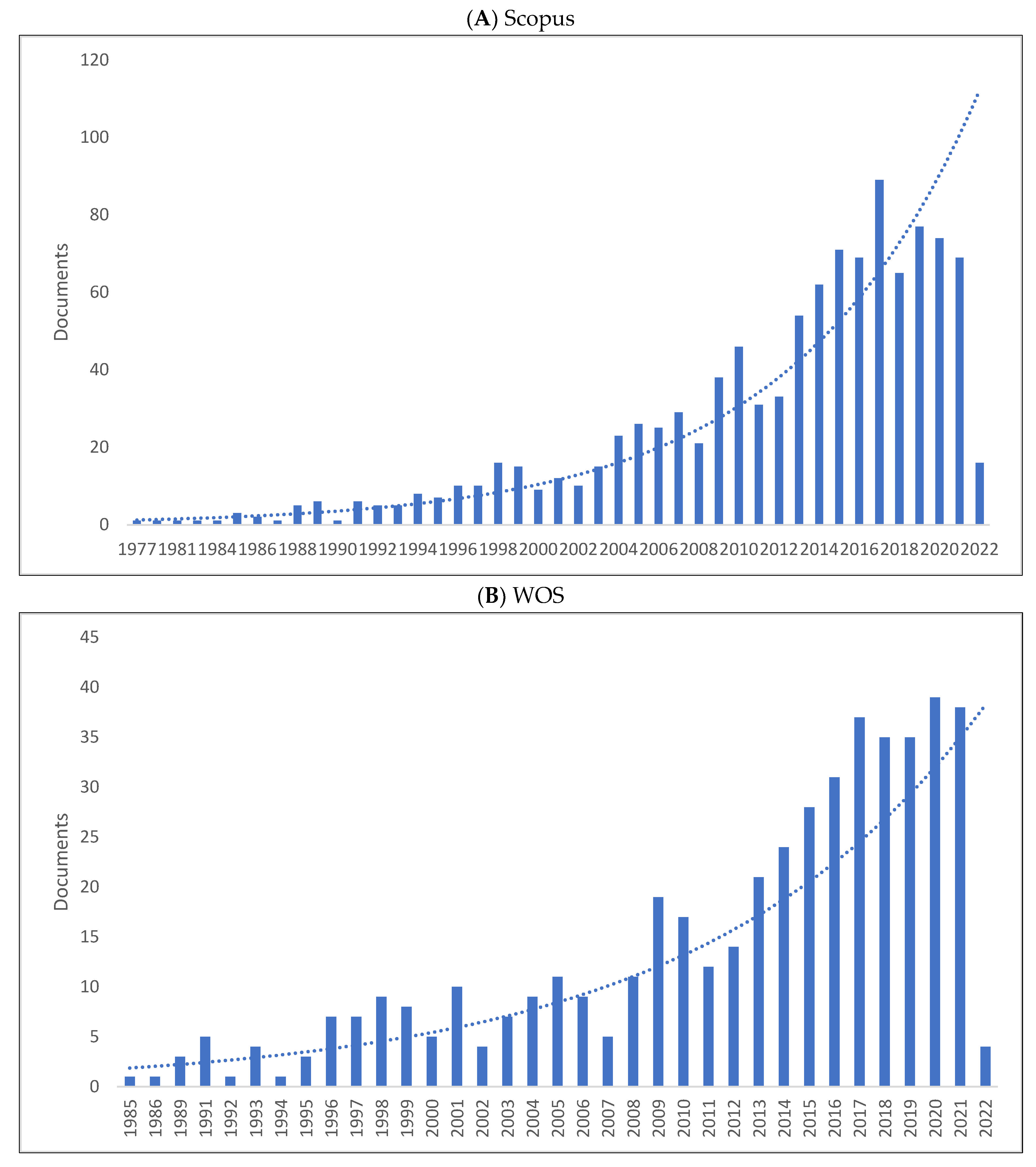
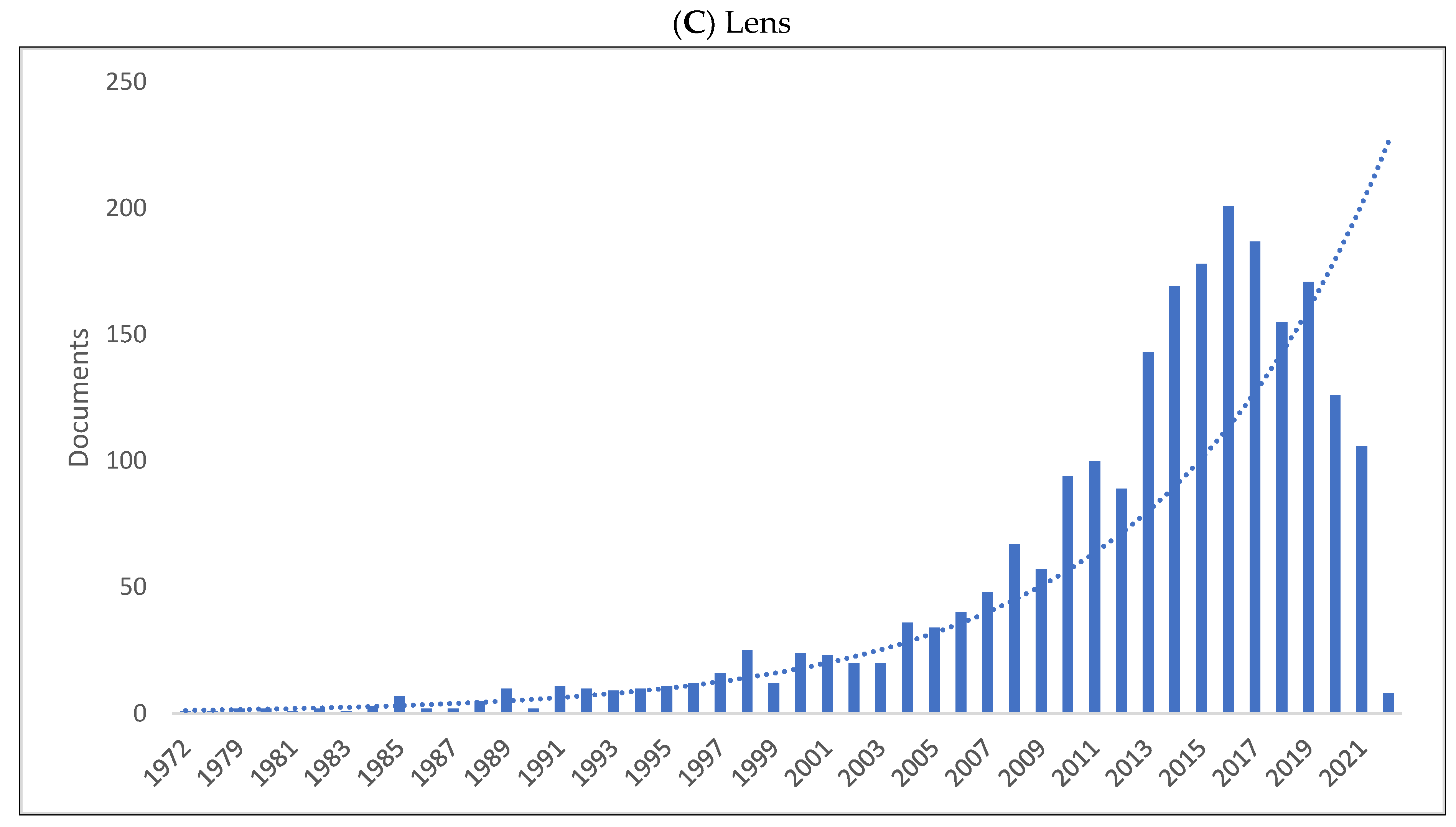

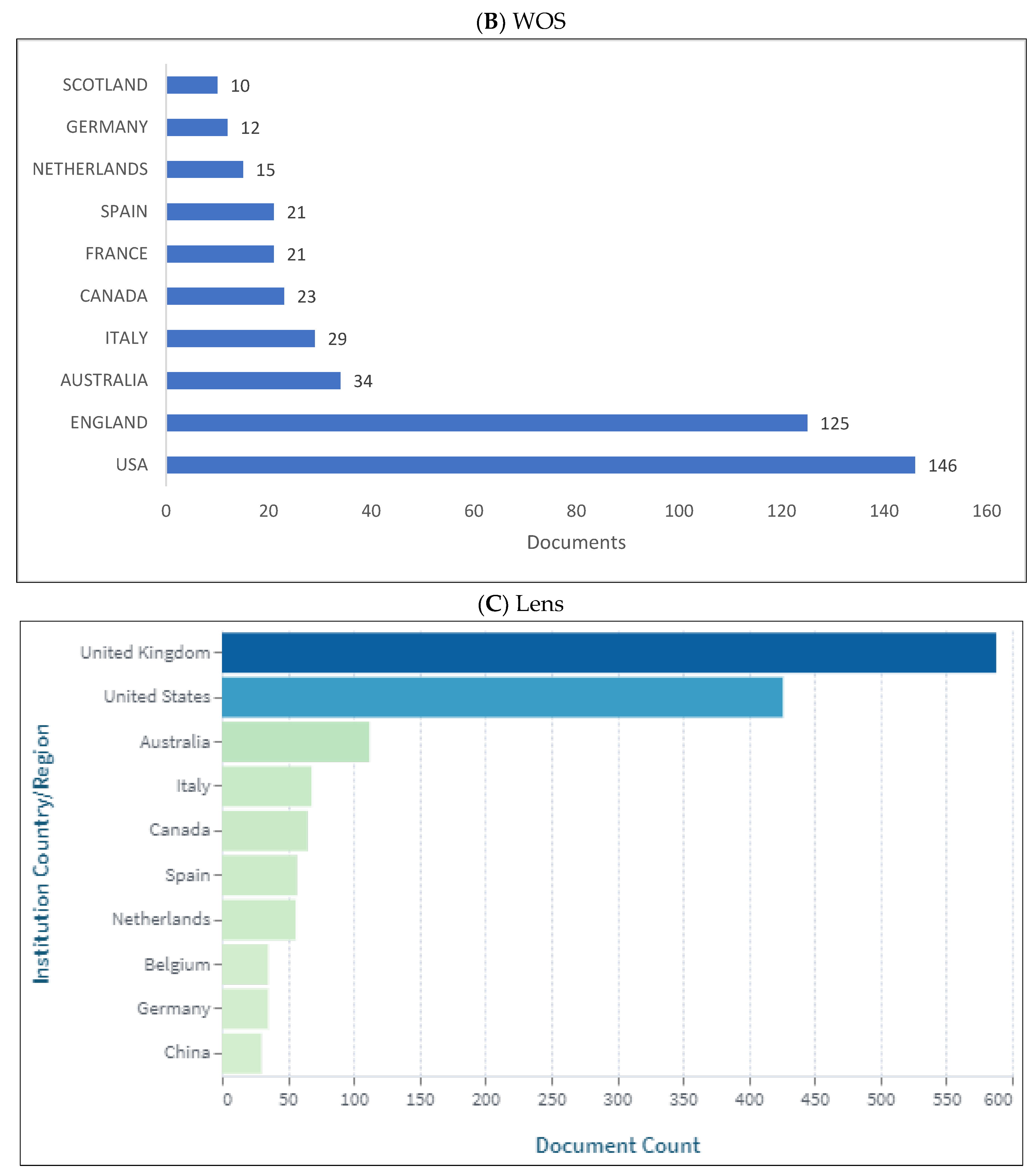

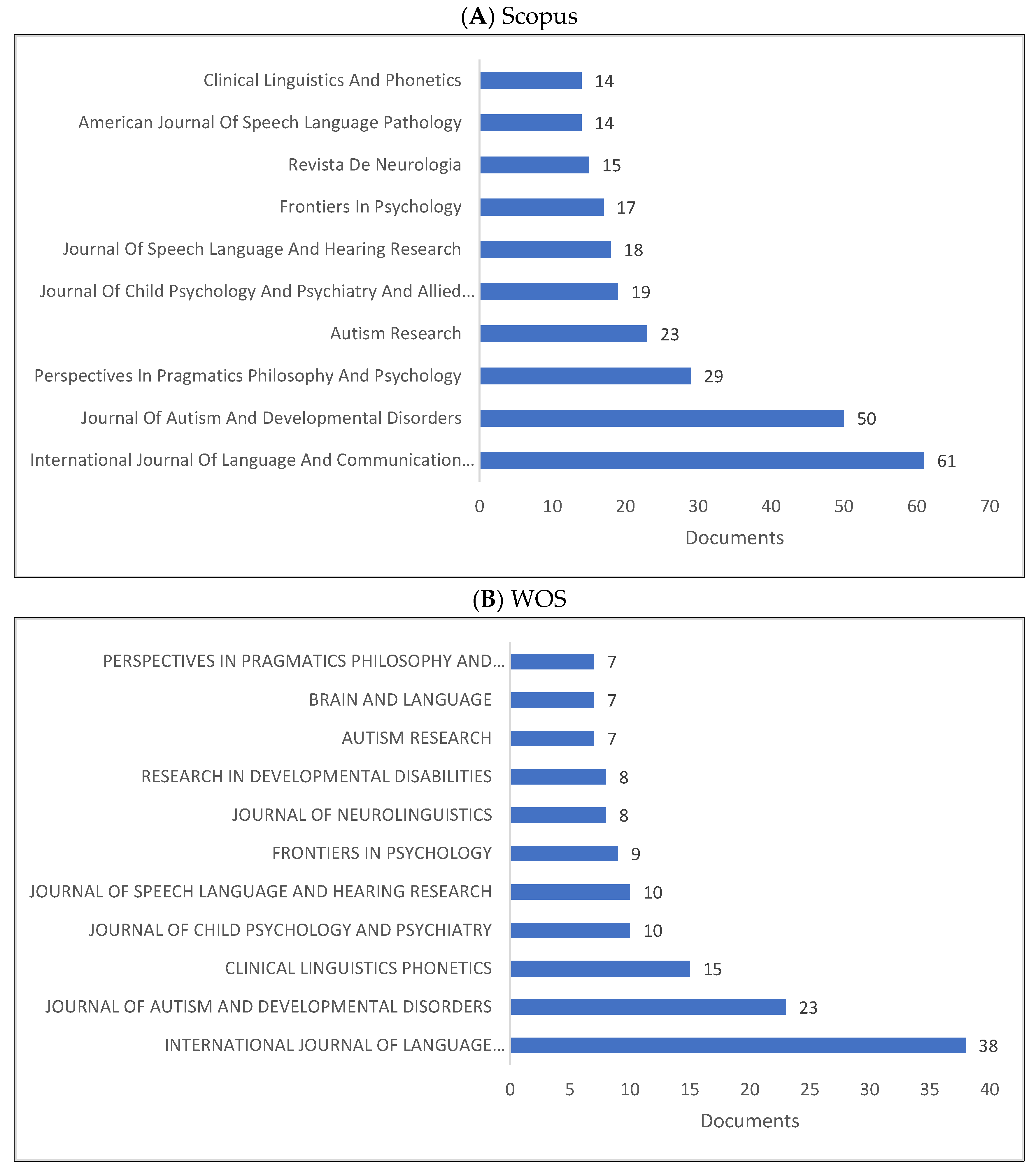
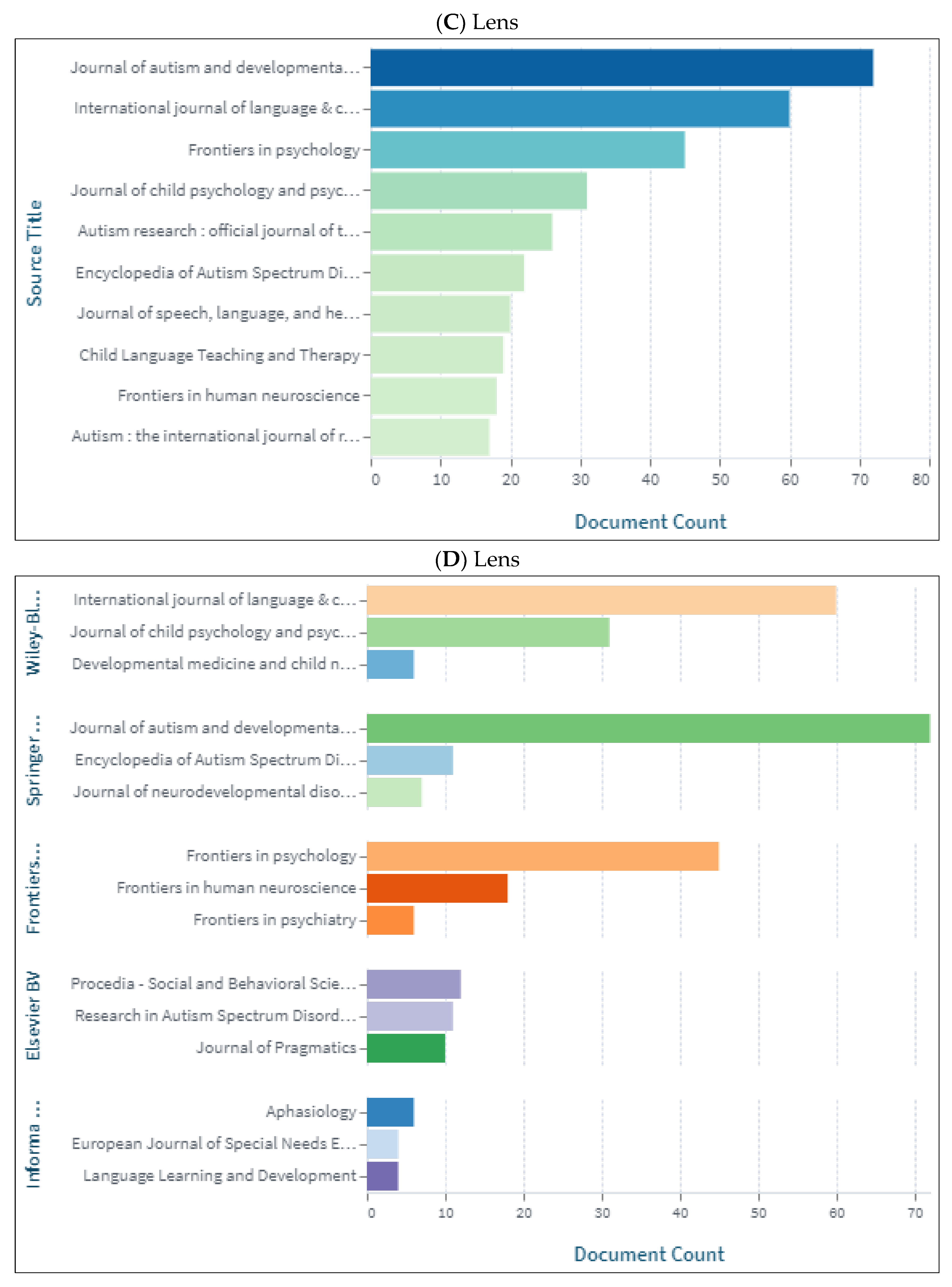
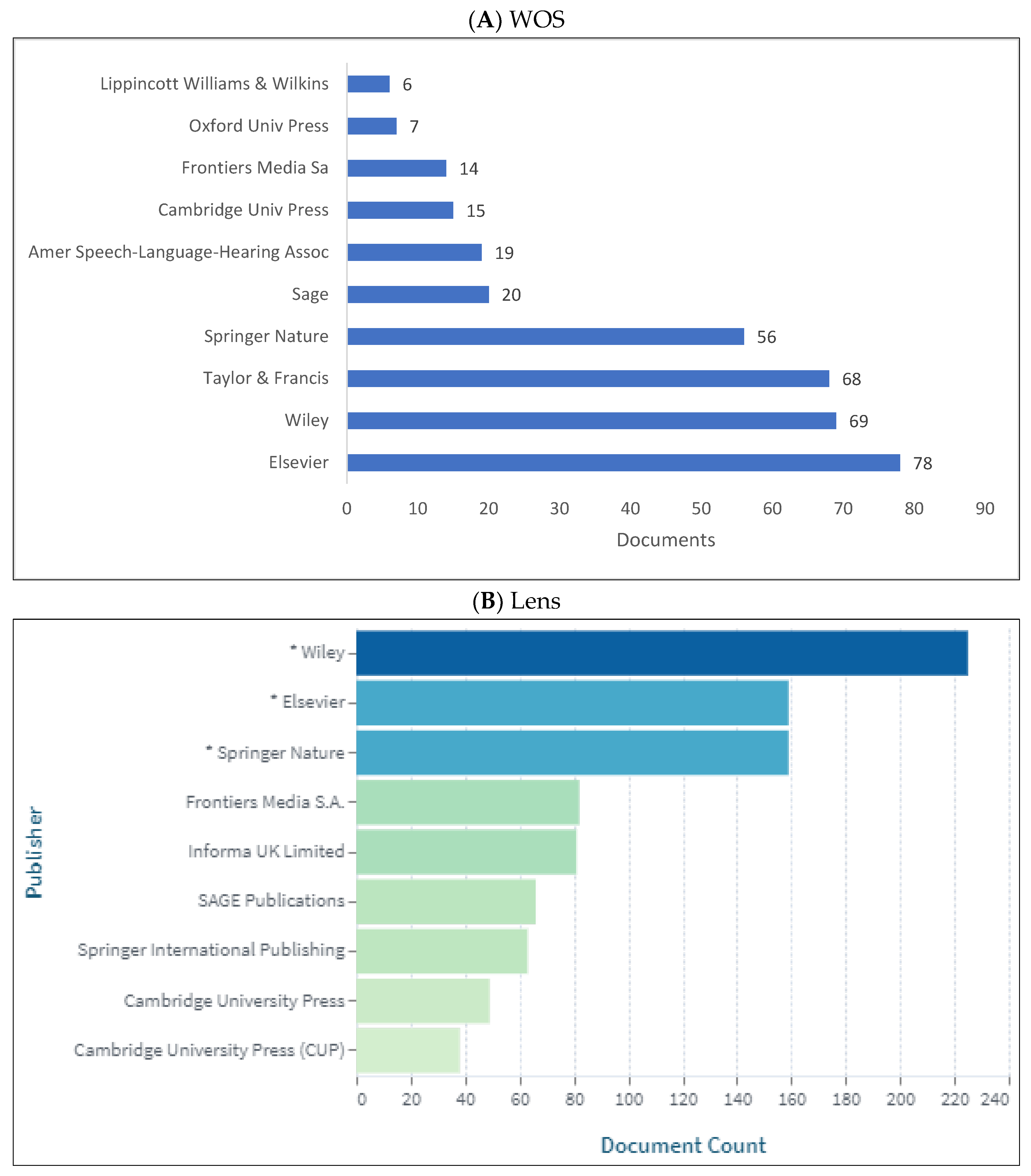

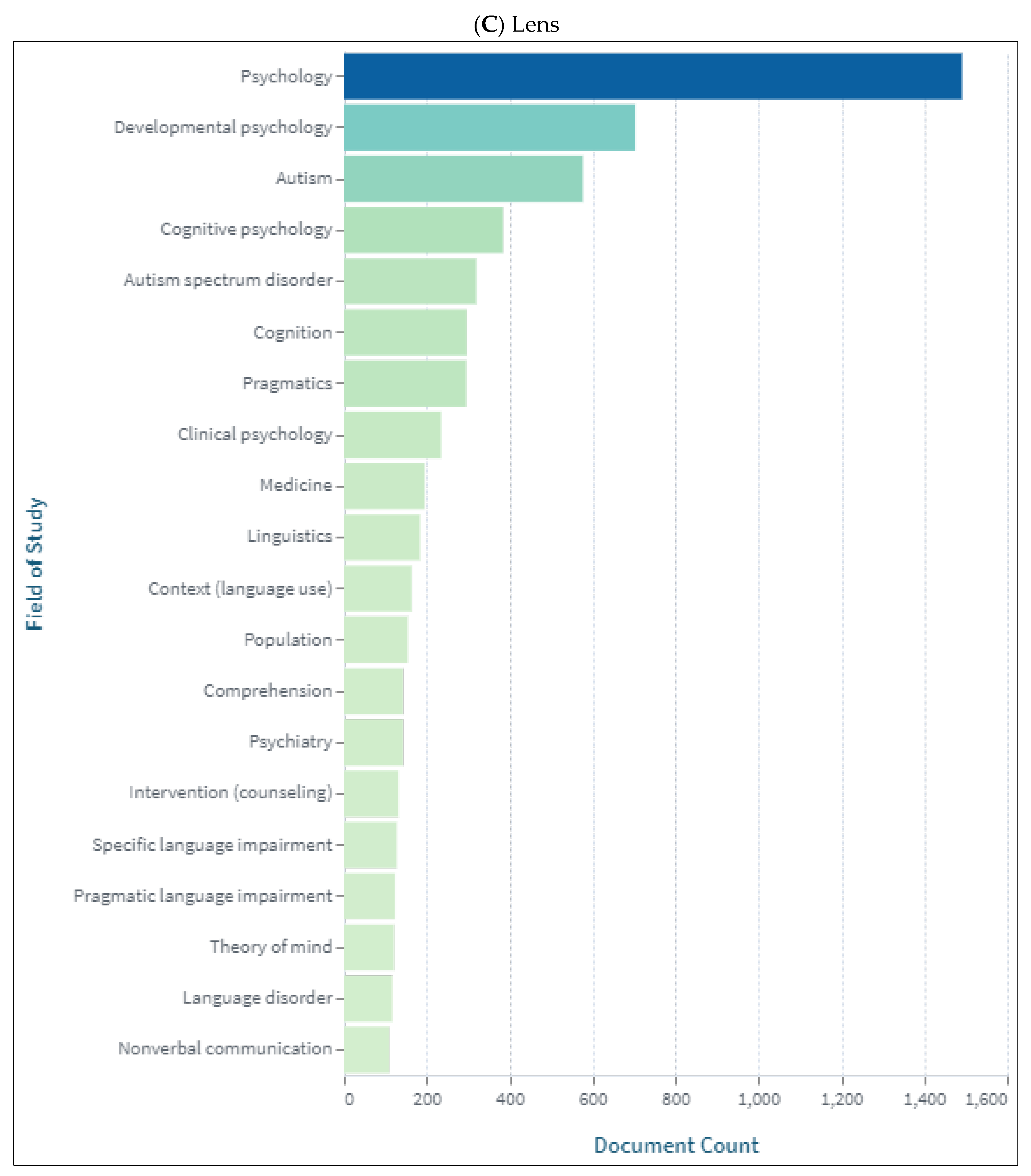
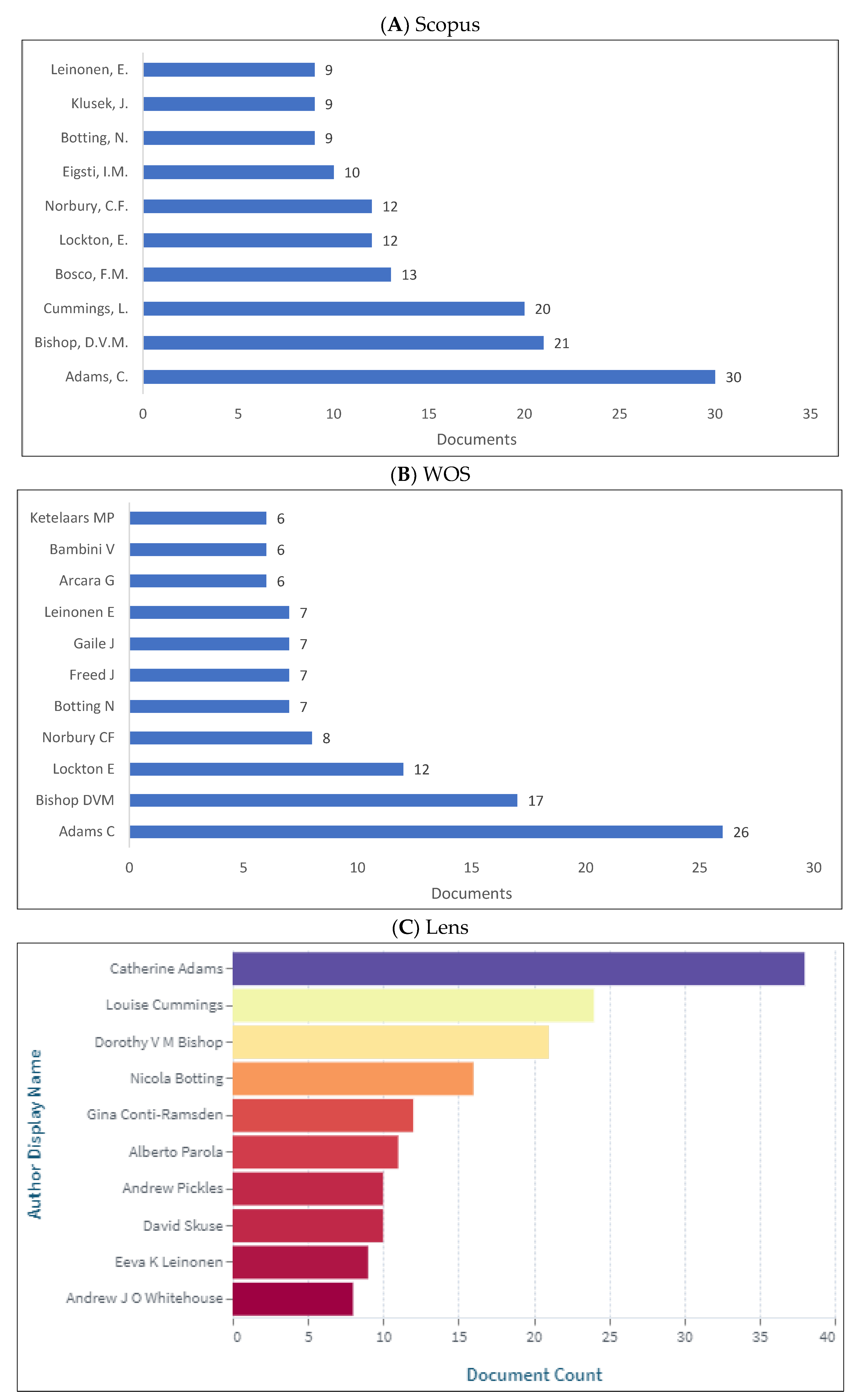
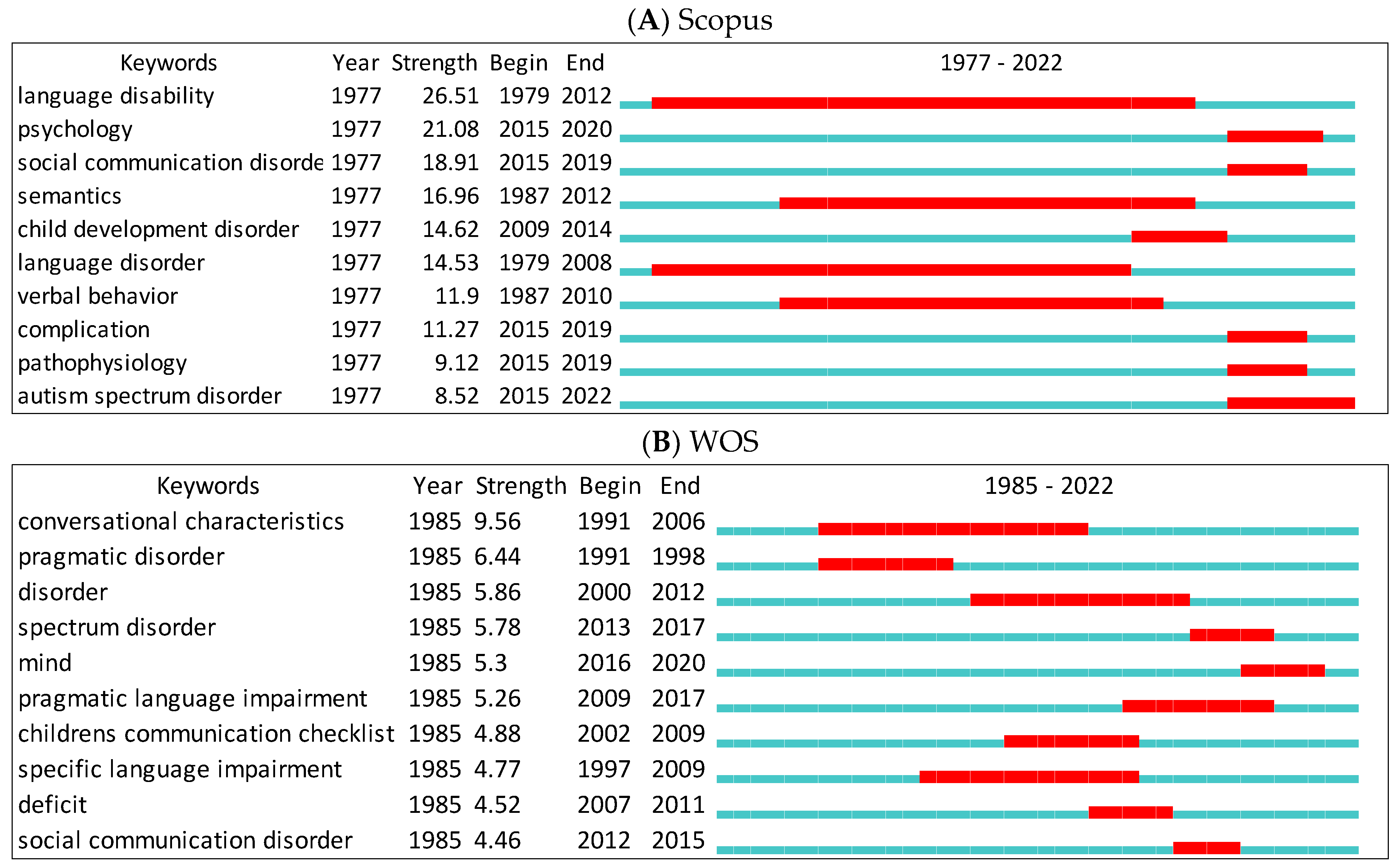

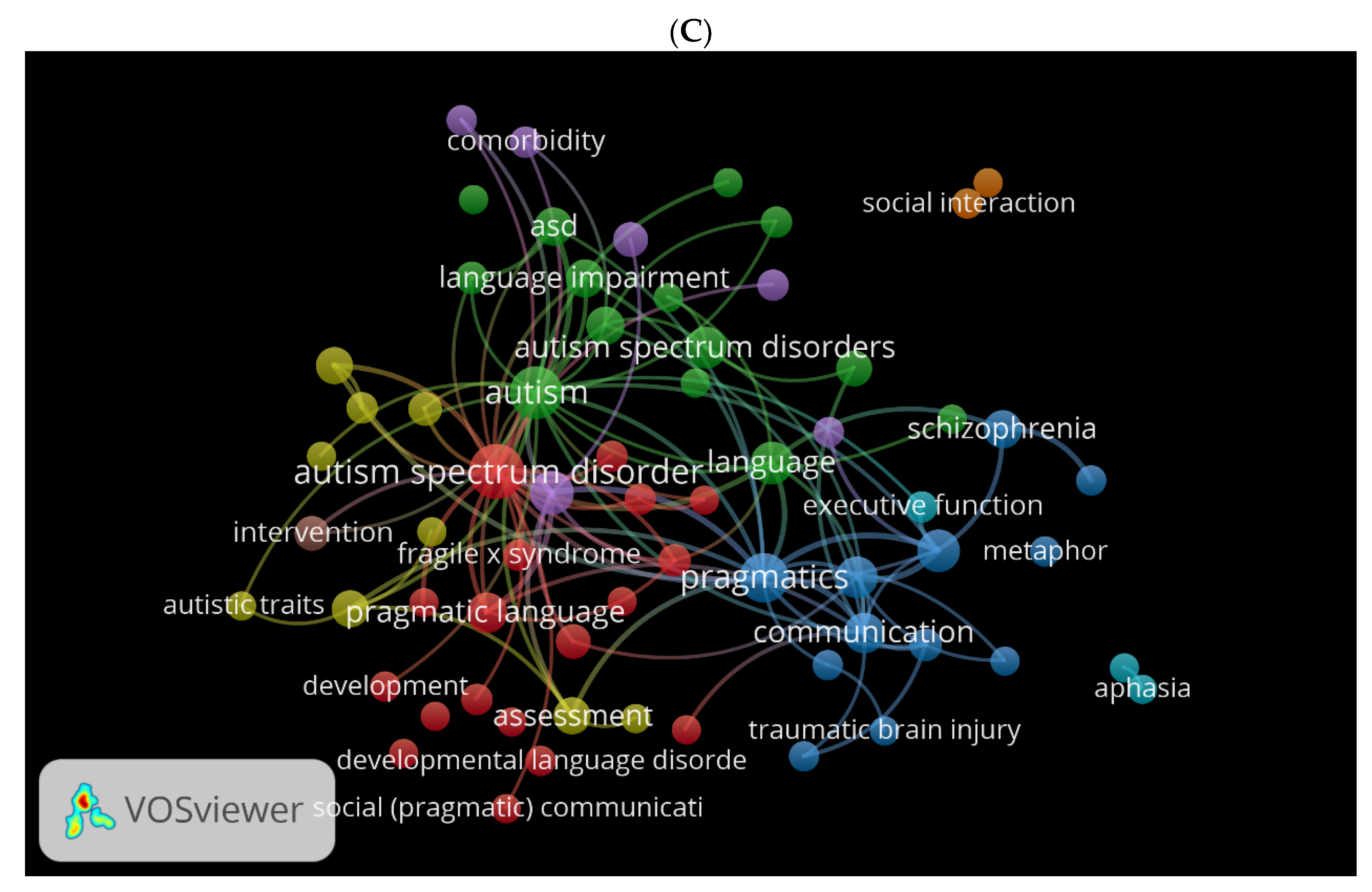

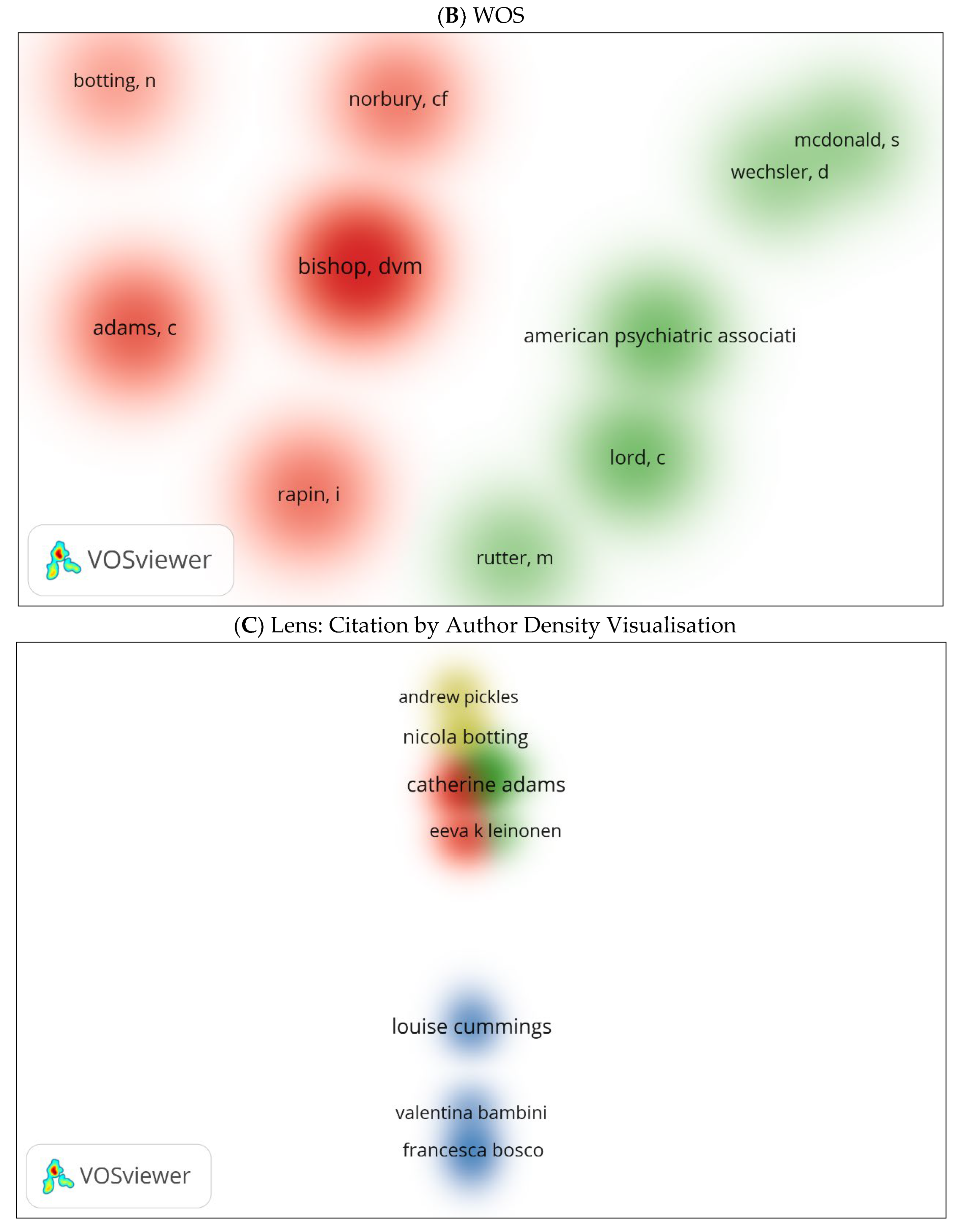



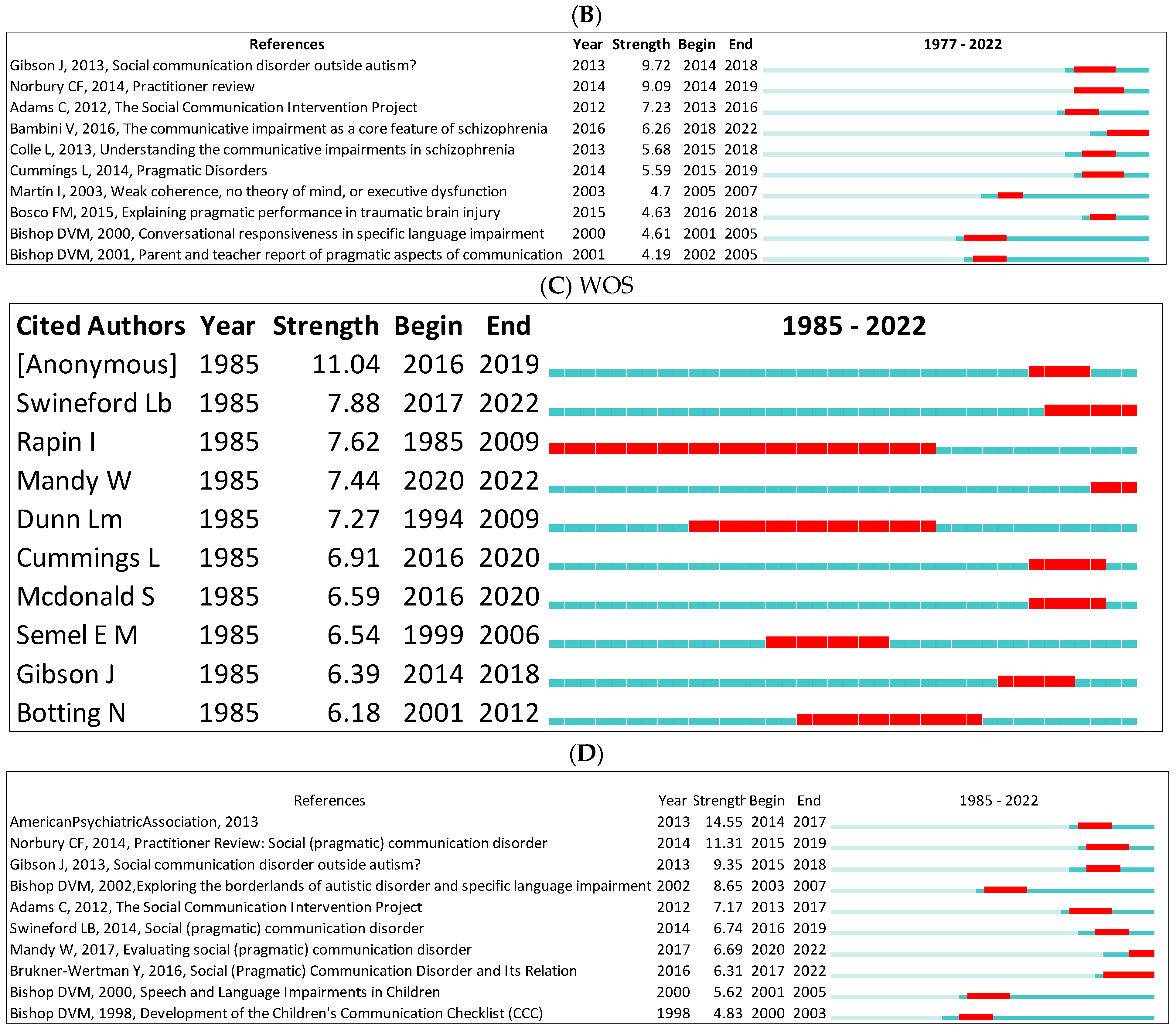
| Indicator: 1–8 Bibliometric; 9–16 Scientometric | Operationalisation | Database/Software | |||
|---|---|---|---|---|---|
| Scopus | WOS | Lens | |||
| Year 1 | Production size by year | √ | √ | √ | |
| Country 2 | Top countries publishing in the field | √ | √ | √ | |
| University 3 | Top universities, research centres, etc. | √ | √ | √ | |
| Source 4 | Top journals, book series, etc. | √ | √ | √ | |
| Publisher 5 | Top publishers | Χ | √ | √ | |
| Subject area 6 | Top fields associated with the field | √ | √ | √ | |
| Author 7 | Top authors publishing in the field | √ | √ | √ | |
| Citation 8 | Top cited documents | √ | √ | √ | |
| CiteSpace | VOSviewer | ||||
| Betweenness centrality 9 | A path between nodes which is achieved when located between two nodes [56] | √ | Χ | ||
| Burst detection 10 | Determines the frequency of a certain event in certain period (e.g., the frequent citation of a certain reference during a period of time) [57] | √ | Χ | ||
| Co-citation 11 | When two references are cited by a third reference [58]. CiteSpace provides a document co-citation network for references and an author co-citation network for authors. In VOSviewer, defined thus: “the relatedness of items is determined based on the number of times they are cited together” [55] (p. 5). Units of analysis include cited authors, references, or sources. | √ | √ | ||
| Silhouette 12 | Used in cluster analysis to measure consistency of each cluster with its related nodes [54] | √ | Χ | ||
| Sigma 13 | Used to measure strength of a node in terms of betweenness centrality citation burst [54] | √ | Χ | ||
| Clusters 14 | “We can probably eyeball the visualised network and identify some prominent groupings” [54] (p. 23). | √ | √ | ||
| Citation 15 | “The relatedness of items is determined based on the number of times they cite each other” [55] (p. 5). Units of analysis include documents, sources, authors, organisations, or countries. | √ | √ | ||
| Keywords 16 | CiteSpace provides co-occurring author keywords and keywords plus. In VOSviewer, defined thus: “the relatedness of items is determined based on the number of documents in which they occur together” [55] (p. 5). Units of analysis include author keywords, all keywords, or keywords plus. | √ | √ | ||
| Scopus ( TITLE-ABS-KEY ( “pragmatic language impairment” ) OR TITLE-ABS-KEY ( “pragmatic impairment” ) OR TITLE-ABS-KEY ( “pragmatic language difficulty” ) OR TITLE-ABS-KEY ( “pragmatic difficulty” ) OR TITLE-ABS-KEY ( “pragmatic language challenges” ) OR TITLE-ABS-KEY ( “pragmatic challenges” ) OR TITLE-ABS-KEY ( “pragmatic language deficit” ) OR TITLE-ABS-KEY ( “pragmatic deficit” ) OR TITLE-ABS-KEY ( “pragmatic language disorder” ) OR TITLE-ABS-KEY ( “pragmatic disorder” ) OR TITLE-ABS-KEY ( “social communication disorder” ) OR TITLE-ABS-KEY ( “pragmatic communication disorder” ) OR TITLE-ABS-KEY ( “social pragmatic communication disorder” ) OR TITLE-ABS-KEY ( “semantic pragmatic disorder” ) OR TITLE-ABS-KEY ( “semantic pragmatic syndrome” ) OR TITLE-ABS-KEY ( “social communicative impairment” ) OR TITLE-ABS-KEY ( “social communicative deficit” ) OR TITLE-ABS-KEY ( “pragmatic language disability” ) OR TITLE-ABS-KEY ( “pragmatic disability” ) OR TITLE-ABS-KEY ( “pragmatic language dysfunction” ) OR TITLE-ABS-KEY ( “pragmatic dysfunction” ) ) AND ( LIMIT-TO ( DOCTYPE , “ar” ) OR LIMIT-TO ( DOCTYPE , “re” ) OR LIMIT-TO ( DOCTYPE , “ch” ) OR LIMIT-TO ( DOCTYPE , “cp” ) OR LIMIT-TO ( DOCTYPE , “bk” ) ) Wednesday, 30 March 2022, 1069 document results, 1977–2022 |
| WOS “pragmatic language impairment” (Topic) or “pragmatic impairment” (Topic) or “pragmatic language difficulty” (Topic) or “pragmatic difficulty” (Topic) or “pragmatic language challenges” (Topic) or “pragmatic challenges” (Topic) or “pragmatic language deficit” (Topic) or “pragmatic deficit” (Topic) or “pragmatic language disorder” (Topic) or “pragmatic disorder” (Topic) or “social communication disorder” (Topic) or “pragmatic communication disorder” (Topic) or “social pragmatic communication disorder” (Topic) or “semantic pragmatic disorder” (Topic) or “semantic-pragmatic disorder” (Topic) or “atypical social interactions” (Topic) or “social-communicative impairment” (Topic) or “social communicative impairment” (Topic) or “social-communicative deficit” (Topic) or “social communicative deficit” (Topic) or “pragmatic language disability” (Topic) or “pragmatic disability” (Topic) or “pragmatic language dysfunction” (Topic) or “pragmatic dysfunction” (Topic) or “pragmatic language abnormalities” (Topic) or “pragmatic abnormalities” (Topic) or “pragmatic breakdown” (Topic) or “semantic-pragmatic syndrome” (Topic) or “semantic pragmatic syndrome” (Topic) or “pragmatic and conversational deficit” (Topic) or “conversational disability” (Topic) or “verbal and non-verbal communication deficits” (Topic) or “pragmatic aphasia” (Topic) or “pragmatic dysphasia” (Topic) or “pragmatic and social difficulties” (Topic) and Articles or Review Articles or Book Chapters or Early Access or Proceedings Papers (Document Types) Wednesday, 30 March 2022, 475 results, 1985–2022 |
| Lens ( Title: ( AND ( “pragmatic language impairment” AND ) ) OR ( Abstract: ( AND ( “pragmatic language impairment” AND ) ) OR Full Text: ( AND ( “pragmatic language impairment” AND ) ) ) ) OR ( ( Title: ( AND ( “pragmatic impairment” AND ) ) OR ( Abstract: ( AND ( “pragmatic impairment” AND ) ) OR Full Text: ( AND ( “pragmatic impairment” AND ) ) ) ) OR ( ( Title: ( AND ( “pragmatic language difficulty” AND ) ) OR ( Abstract: ( AND ( “pragmatic language difficulty” AND ) ) OR Full Text: ( AND ( “pragmatic language difficulty” AND ) ) ) ) OR ( ( Title: ( AND ( “pragmatic difficulty” AND ) ) OR ( Abstract: ( AND ( “pragmatic difficulty” AND ) ) OR Full Text: ( AND ( “pragmatic difficulty” AND ) ) ) ) OR ( ( Title: ( AND ( “pragmatic language challenges” AND ) ) OR ( Abstract: ( AND ( “pragmatic language challenges” AND ) ) OR Full Text: ( AND ( “pragmatic language challenges” AND ) ) ) ) OR ( ( Title: ( AND ( “pragmatic challenges” AND ) ) OR ( Abstract: ( AND ( “pragmatic challenges” AND ) ) OR Full Text: ( AND ( “pragmatic challenges” AND ) ) ) ) OR ( ( Title: ( AND ( “pragmatic language deficit” AND ) ) OR ( Abstract: ( AND ( “pragmatic language deficit” AND ) ) OR Full Text: ( AND ( “pragmatic language deficit” AND ) ) ) ) OR ( ( Title: ( AND ( “pragmatic deficit” AND ) ) OR ( Abstract: ( AND ( “pragmatic deficit” AND ) ) OR Full Text: ( AND ( “pragmatic deficit” AND ) ) ) ) OR ( ( Title: ( AND ( “pragmatic language disorder” AND ) ) OR ( Abstract: ( AND ( “pragmatic language disorder” AND ) ) OR Full Text: ( AND ( “pragmatic language disorder” AND ) ) ) ) OR ( ( Title: ( AND ( “pragmatic disorder” AND ) ) OR ( Abstract: ( AND ( “pragmatic disorder” AND ) ) OR Full Text: ( AND ( “pragmatic disorder” AND ) ) ) ) OR ( ( Title: ( AND ( “social communication disorder” AND ) ) OR ( Abstract: ( AND ( “social communication disorder” AND ) ) OR Full Text: ( AND ( “social communication disorder” AND ) ) ) ) OR ( ( Title: ( AND ( “pragmatic communication disorder” AND ) ) OR ( Abstract: ( AND ( “pragmatic communication disorder” AND ) ) OR Full Text: ( AND ( “pragmatic communication disorder” AND ) ) ) ) OR ( ( Title: ( AND ( “social pragmatic communication disorder” AND ) ) OR ( Abstract: ( AND ( “social pragmatic communication disorder” AND ) ) OR Full Text: ( AND ( “social pragmatic communication disorder” AND ) ) ) ) OR ( ( Title: ( AND ( “semantic pragmatic disorder” AND ) ) OR ( Abstract: ( AND ( “semantic pragmatic disorder” AND ) ) OR Full Text: ( AND ( “semantic pragmatic disorder” AND ) ) ) ) OR ( ( Title: ( AND ( “atypical social interactions” AND ) ) OR ( Abstract: ( AND ( “atypical social interactions” AND ) ) OR Full Text: ( AND ( “atypical social interactions” AND ) ) ) ) OR ( ( Title: ( AND ( “social-communicative impairment” AND ) ) OR ( Abstract: ( AND ( “social-communicative impairment” AND ) ) OR Full Text: ( AND ( “social-communicative impairment” AND ) ) ) ) OR ( ( Title: ( AND ( “social communicative impairment” AND ) ) OR ( Abstract: ( AND ( “social communicative impairment” AND ) ) OR Full Text: ( AND ( “social communicative impairment” AND ) ) ) ) OR ( ( Title: ( AND ( “social-communicative deficit” AND ) ) OR ( Abstract: ( AND ( “social-communicative deficit” AND ) ) OR Full Text: ( AND ( “social-communicative deficit” AND ) ) ) ) OR ( ( Title: ( AND ( “pragmatic language disability” AND ) ) OR ( Abstract: ( AND ( “pragmatic language disability” AND ) ) OR Full Text: ( AND ( “pragmatic language disability” AND ) ) ) ) OR ( ( Title: ( AND ( “pragmatic disability” AND ) ) OR ( Abstract: ( AND ( “pragmatic disability” AND ) ) OR Full Text: ( AND ( “pragmatic disability” AND ) ) ) ) OR ( ( Title: ( AND ( “pragmatic language dysfunction” AND ) ) OR ( Abstract: ( AND ( “pragmatic language dysfunction” AND ) ) OR Full Text: ( AND ( “pragmatic language dysfunction” AND ) ) ) ) OR ( ( Title: ( AND ( “pragmatic dysfunction” AND ) ) OR ( Abstract: ( AND ( “pragmatic dysfunction” AND ) ) OR Full Text: ( AND ( “pragmatic dysfunction” AND ) ) ) ) OR ( ( Title: ( AND ( “pragmatic language abnormalities” AND ( AND ) ) ) OR ( Abstract: ( AND ( “pragmatic language abnormalities” AND ( AND ) ) ) OR Full Text: ( AND ( “pragmatic language abnormalities” AND ( AND ) ) ) ) ) OR ( ( Title: ( AND ( “pragmatic abnormalities” AND ( AND ) ) ) OR ( Abstract: ( AND ( “pragmatic abnormalities” AND ( AND ) ) ) OR Full Text: ( AND ( “pragmatic abnormalities” AND ( AND ) ) ) ) ) OR ( ( Title: ( AND ( “pragmatic breakdown” AND ) ) OR ( Abstract: ( AND ( “pragmatic breakdown” AND ) ) OR Full Text: ( AND ( “pragmatic breakdown” AND ) ) ) ) OR ( ( Title: ( AND ( “semantic pragmatic syndrome” AND ) ) OR ( Abstract: ( AND ( “semantic pragmatic syndrome” AND ) ) OR Full Text: ( AND ( “semantic pragmatic syndrome” AND ) ) ) ) OR ( ( Title: ( AND ( “pragmatic and conversational deficit” AND ) ) OR ( Abstract: ( AND ( “pragmatic and conversational deficit” AND ) ) OR Full Text: ( AND ( “pragmatic and conversational deficit” AND ) ) ) ) OR ( ( Title: ( AND ( “conversational disability” AND ) ) OR ( Abstract: ( AND ( “conversational disability” AND ) ) OR Full Text: ( AND ( “conversational disability” AND ) ) ) ) OR ( ( Title: ( AND ( “verbal and non-verbal communication deficits” AND ) ) OR ( Abstract: ( AND ( “verbal and non-verbal communication deficits” AND ) ) OR Full Text: ( AND ( “verbal and non-verbal communication deficits” AND ) ) ) ) OR ( ( Title: ( AND ( “pragmatic aphasia” AND ) ) OR ( Abstract: ( AND ( “pragmatic aphasia” AND ) ) OR Full Text: ( AND ( “pragmatic aphasia” AND ) ) ) ) OR ( ( Title: ( AND ( “pragmatic dysphasia” AND ) ) OR ( Abstract: ( AND ( “pragmatic dysphasia” AND ) ) OR Full Text: ( AND ( “pragmatic dysphasia” AND ) ) ) ) OR ( Title: ( AND ( “pragmatic and social difficulties” AND ) ) OR ( Abstract: ( AND ( “pragmatic and social difficulties” AND ) ) OR Full Text: ( AND ( “pragmatic and social difficulties” AND ) ) ) ) ) ) ) ) ) ) ) ) ) ) ) ) ) ) ) ) ) ) ) ) ) ) ) ) ) ) ) ) ) ) Filters: Publication Type = ( journal article , book chapter , unknown , book , dissertation , conference proceedings article ) Wednesday, 30 March 2022, 2308 Scholarly Works, 1977–2022 |
| No. | Source Title | Citation | Citations |
|---|---|---|---|
| 1 | A Behavioral Comparison of Male and Female Adults with High Functioning Autism Spectrum Conditions | [61] | 410 |
| 2 | Acquired “theory of mind” impairments following stroke | [62] | 339 |
| 3 | Action Anticipation Through Attribution of False Belief by 2-Year-Olds | [63] | 679 |
| 4 | Development of the Children’s Communication Checklist (CCC): A method for assessing qualitative aspects of communicative impairment in children | [9] | 592 |
| 5 | Exploring the borderlands of autistic disorder and specific language impairment: A study using standardised diagnostic instruments | [14] | 322 |
| 6 | Gaze cueing of attention: visual attention, social cognition, and individual differences. | [64] | 992 |
| 7 | Health effects of housing improvement: Systematic review of intervention studies | [65] | 251 |
| 8 | Inferential processing and story recall in children with communication problems: a comparison of specific language impairment, pragmatic language impairment and high-functioning autism | [13] | 181 |
| 9 | Narrative skills of children with communication impairments | [22] | 412 |
| 10 | Neural basis of irony comprehension in children with autism: The role of prosody and context | [66] | 248 |
| 11 | Phase 2 of CATALISE: a multinational and multidisciplinary Delphi consensus study of problems with language development: Terminology | [67] | 532 |
| 12 | Precise minds in uncertain worlds: Predictive coding in autism | [68] | 409 |
| 13 | Preliminary communication social language use in parents of autistic individuals | [69] | 239 |
| 14 | Psychosis and autism as diametrical disorders of the social brain | [70] | 446 |
| 15 | Sensitivity and specificity of proposed DSM-5 diagnostic criteria for autism spectrum disorder | [71] | 261 |
| 16 | Social and pragmatic deficits in autism: Cognitive or affective? | [72] | 578 |
| 17 | Social Difficulties and Victimisation in Children with SLI at 11 Years of Age | [73] | 221 |
| 18 | The extent to which psychometric tests differentiate subgroups of children with SLI | [74] | 209 |
| 19 | The eye contact effect: mechanisms and development | [75] | 552 |
| 20 | The screening and diagnosis of autistic spectrum disorders | [76] | 616 |
| 21 | Using a parental checklist to identify diagnostic groups in children with communication impairment: a validation of the Children’s Communication Checklist–2 | [77] | 175 |
| 22 | Weak coherence, no theory of mind, or executive dysfunction? Solving the puzzle of pragmatic language disorders | [36] | 235 |
| Cluster ID | Size | Silhouette | Label (LSI) | Label (LLR) | Label (MI) | Average Year |
|---|---|---|---|---|---|---|
| Scopus | ||||||
| 0 | 171 | 0.615 | social communication disorder | children’s communication checklist (766.8, 1.0 × 10−4) | behavioural problem (2.48) | 2007 |
| 1 | 157 | 0.811 | traumatic brain injury | traumatic brain injury | behavioural problem (1.45) | 2010 |
| 2 | 107 | 0.635 | autism spectrum disorder | autism spectrum disorder | behavioural problem (1.94) | 2011 |
| 3 | 87 | 0.866 | autism spectrum disorder | contingent relationship | behavioural problem (0.19) | 1988 |
| 4 | 71 | 0.779 | autism spectrum disorder | Asperger’s syndrome | belief report (1.07) | 2007 |
| 5 | 57 | 0.92 | autism spectrum disorder | DSM-5 diagnostic criteria | behavioural problem (0.38) | 2010 |
| WOS | ||||||
| 0 | 164 | 0.638 | autism spectrum disorder | traumatic brain injury | diagnostic observation schedule score (3.04) | 2006 |
| 1 | 96 | 0.835 | inferential meaning | inferential meaning | assessing qualitative aspect (0.9) | 1996 |
| 2 | 94 | 0.897 | traumatic brain injury | traumatic brain injury | irony elaboration (1.1) | 2014 |
| 3 | 90 | 0.871 | Asperger’s syndrome | Asperger’s syndrome | diagnostic observation schedule score (0.52) | 2002 |
| WoS | Scopus | ||||
|---|---|---|---|---|---|
| Citation | Reference | Cluster ID | Citation | Reference | Cluster ID |
| 184 | Bishop [81] | 0 | 243 | Bishop [20] | 0 |
| 128 | American Psychiatric Association [6] | 0 | 214 | Lord [80] | 2 |
| 118 | Adams [81] | 0 | 170 | Baron-Cohen [72] | 4 |
| 92 | Rapin [7] | 0 | 155 | Adams [81] | 0 |
| 91 | Lord [82] | 0 | 145 | [Anonymous], 1979 | 8 |
| 83 | Norbury [83] | 0 | 139 | Rapin [17] | 0 |
| 54 | Rutter [84] | 0 | 126 | Norbury [77] | 0 |
| 53 | Wechsler [85] | 1 | 122 | Tager-Flusberg [86] | 0 |
| 47 | Botting [87] | 0 | 109 | Rutter [88] | 0 |
| 47 | Tager-Flusberg [86] | 0 | 103 | Wechsler [85] | 0 |
| WoS | Scopus | ||||
|---|---|---|---|---|---|
| Burst | Reference | Cluster ID | Burst | Reference | Cluster ID |
| 11.04 | [Anonymous], 2014 | 2 | 14.95 | Rapin [17] | 0 |
| 7.88 | Swineford [90] | 4 | 11.68 | Cummings [89] | 1 |
| 7.62 | Rapin [17] | 0 | 11.16 | Mctear [91] | 0 |
| 7.44 | Mandy [92] | 4 | 10.86 | Botting [87] | 0 |
| 7.27 | Dunn [93] | 1 | 9.93 | Douglas [94] | 1 |
| 6.91 | Cummings [95] | 2 | 8.91 | Conti-Ramsden [96] | 0 |
| 6.59 | Mcdonald [97] | 2 | 8.79 | Bosco [98] | 1 |
| 6.54 | Semel [99] | 0 | 8.56 | Shields [12] | 0 |
| 6.39 | Gibson [27] | 0 | 8.47 | Mandy [92] | 0 |
| 6.18 | Botting [87] | 0 | 8.14 | Bambini [60] | 1 |
| WoS | Scopus | ||||
|---|---|---|---|---|---|
| Centrality | Reference | Cluster ID | Centrality | Reference | Cluster ID |
| 134 | Adams [81] | 0 | 109 | Bishop [20] | 0 |
| 127 | Bishop [81] | 0 | 99 | Martin [100] | 1 |
| 123 | American Psychiatric Association [6] | 0 | 99 | McDonald [101] | 1 |
| 111 | Baron Cohen [102] | 3 | 97 | Rapin [17] | 0 |
| 99 | Bishop [103] | 1 | 97 | Lord [80] | 2 |
| 92 | Rapin [7] | 0 | 94 | Adams [81] | 0 |
| 72 | Botting [87] | 0 | 92 | Baron-Cohen [72] | 4 |
| 70 | Conti-Ramsden [104] | 1 | 91 | Botting [87] | 0 |
| 67 | Brinton [105] | 5 | 84 | Norbury [77] | 0 |
| 65 | Rutter [84] | 0 | 81 | Conti-Ramsden [96] | 0 |
| WoS | Scopus | ||||
|---|---|---|---|---|---|
| Sigma | Reference | Cluster ID | Sigma | Reference | Cluster ID |
| 0 | Adams [81] | 0 | 0 | Bishop [20] | 0 |
| 0 | Bishop [81] | 0 | 0 | Martin [100] | 1 |
| 0 | American Psychiatric Association [6] | 0 | 0 | McDonald [101] | 1 |
| 0 | Baron Cohen [102] | 3 | 0 | Rapin [17] | 0 |
| 0 | Bishop [103] | 1 | 0 | Lord [80] | 2 |
| 0 | Rapin [7] | 0 | 0 | Adams [81] | 0 |
| 0 | Botting [87] | 0 | 0 | Baron-Cohen [72] | 4 |
| 0 | Conti-Ramsden [104] | 1 | 0 | Botting [87] | 0 |
| 0 | Brinton [105] | 5 | 0 | Norbury [77] | 0 |
| 0 | Rutter [84] | 0 | 0 | Conti-Ramsden [96] | 0 |
Disclaimer/Publisher’s Note: The statements, opinions and data contained in all publications are solely those of the individual author(s) and contributor(s) and not of MDPI and/or the editor(s). MDPI and/or the editor(s) disclaim responsibility for any injury to people or property resulting from any ideas, methods, instructions or products referred to in the content. |
© 2023 by the authors. Licensee MDPI, Basel, Switzerland. This article is an open access article distributed under the terms and conditions of the Creative Commons Attribution (CC BY) license (https://creativecommons.org/licenses/by/4.0/).
Share and Cite
Alduais, A.; Alfadda, H.; Allegretta, S.; Trivkovic, T. Pragmatic Language Impairment: A Scientometric Review. Appl. Sci. 2023, 13, 9308. https://doi.org/10.3390/app13169308
Alduais A, Alfadda H, Allegretta S, Trivkovic T. Pragmatic Language Impairment: A Scientometric Review. Applied Sciences. 2023; 13(16):9308. https://doi.org/10.3390/app13169308
Chicago/Turabian StyleAlduais, Ahmed, Hind Alfadda, Silvia Allegretta, and Tamara Trivkovic. 2023. "Pragmatic Language Impairment: A Scientometric Review" Applied Sciences 13, no. 16: 9308. https://doi.org/10.3390/app13169308
APA StyleAlduais, A., Alfadda, H., Allegretta, S., & Trivkovic, T. (2023). Pragmatic Language Impairment: A Scientometric Review. Applied Sciences, 13(16), 9308. https://doi.org/10.3390/app13169308






